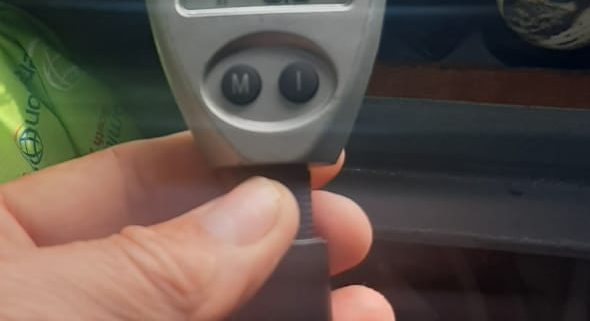Day 11: Rock’ n Roll
Lots of white water 🌊 on top of what looks like double-decker buses rolling in. The amount of energy that created these swells must be enormous.
I can’t remember when I last saw such a big volume of white water. First, you have this huge wall of a wave coming at you from behind. Then the crest of the wave starts to trip over itself. For a moment, you see the “green room”. The light from the other side of the wave today was not green but a beautiful turquoise blue. It’s gone in a flash, replaced by bouncing white frothing water.
9 out of 10 times, the white water washes over Osiyeza’s stern and cockpit, giving a quick forward shove.
The other time it’s the green room that breaks on top of Osiyeza, and the white water tries its hardest to get into the cabin through the washboards and hatch seals. The shove from this type is much more forceful and often leads to a short surf down the face of the wave.
Today is much like last night. Hatches locked, and Osiyeza pointed DownWind. 🤞 Cross the fingers and hold on tight.
I no longer cross my fingers because Osiyeza has proven to be a very seaworthy little craft.
I still do hold on tight.
The ocean’s mood has progressively deteriorated as the hours of the day go by. Around 17:00, I took another peak standing up through the top hatch.
I am very grateful for this design feature. It enables me to stand safely even during the most violent heeling without concern that, one, I might fall overboard, and two, it’s seldom that water can reach the hatch this high to get inside.
When I popped up to study the ocean, I could feel the wind had increased and see that the white water from the sea horses was being blown away as a spray. I stick my electronic wind gauge on its selfie stick out the hatch for a few minutes to get the latest reading. Gusting over 30kn.
No sooner had I put it away than Osiyeza was hit on the starboard quarter by the biggest white water yet. I was knocked down to the one side, and Osiyeza went over almost 90% and almost immediately sat upright again. Only a little bit of water into the cabin through the open hatch.
A minute later, another wave hit from the other side and over we went. Not as far as the first time.
Rock’ n roll.
I say out loud to Osiyeza,” 🤬 it looks like we have our work cut out for us tonight.”
I suddenly have an image of Captain Dan sitting on top of the rigging on the shrimp boat during a storm, cussing at the top of his lungs, and Forest Gump telling him, “Mama says not to use those words, Captain Dan?”
At 19:00, SAST is a scheduled check-in with the shore team and Judy.
During this time, Osiyeza fell down the face of a large wave. We were going so fast that it looked like we had a rooster’s tail out the back.
This was definitely the fastest we have surfed before.
It honestly gave me a big fright.
The water rushed up the paddle cutaways, swamping the cockpit, trying to tear the satellite antenna off its mounting but was saved by the sea anchor bag lashed to the roll bar just in front of it. Everything was OK but not what I was keen to do all night.
Not long after that, we were hit broadside by a crumbling wall of water. I was surprised by how violent the impact was. I went flying, but as I held my cell phone with two hands, my elbows took the brunt of my fall against the side. Eina!
Osiyeza rolled passed 90°. I could see the water through the top hatch. It felt like ages, but I could not have been more than half a second, and we were regular side up again. This one gave me an even greater fright but also put a little more confidence in the design concept.
A design feature that is unusual for kayaks or rowing boats is having a fixed keel or centre board. They often have lifting boards they can push down to help track across the wind.
I sacrificed some drag for the righting moment that a fixed keel offers. To go a step further, there is a 48kg lead bulb at the bottom of the keel to make sure that we pop the right side up very smartly.
Osiyeza has even more tricks up her sleeve. There are two water ballast tanks. One in the bow and one in the stern. I won’t go into the technical aspect of the stepped hull other than to say filling the tanks with seawater will increase the beam of the kayak by 10cm. With the extra weight and beam, she becomes more stable.
Tonight I pumped the rear ballast tank full to make the stern heavier and hopefully reduce the surfing abilities. She definitely feels more stable now. It’s like having another Richard sitting on the back deck all night.
Oh boy, what a shocking night.
No sleep was had.
Maybe the darkness of an overcast night makes things feel and sound dreadful.
Wave after wave crashed over us. Wild out of-control surfing and one impressive attempt at a pitchpole.
Pitch pole: when you bury the bow into a wave, and the stern tries to overtake it, much like a somersault.
As always, I was just a passenger when it happened. The bow buried itself at the bottom of the wave, and the stern seemed to keep going, but eventually, it just flopped back down but lying on its port side. Cockpit facing downwind.
Getting Osiyeza to head in the correct direction took quite a while.
It’s been relentless.
Maybe I should have used the sea anchor instead of running with the storm. I would have lost two days just sitting there, and I am sure sleep would have been deprived either way.
Co-ordinates: -23.2148, 8.8308
Breakfast: yoghurt and nuts
Food: chilli con Carne with noodles
snack bars, salami sticks and droewors.
Sea life: did not spend much time outside
Amount raised for Operation Smile: R156,963
No of new smiles: 28
No of new smiles: 28



